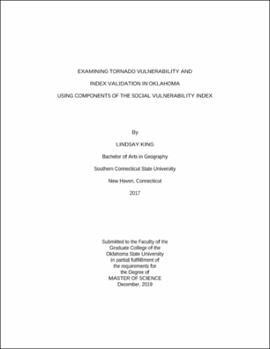| dc.contributor.advisor | Kedron, Peter J. | |
| dc.contributor.author | King, Lindsay | |
| dc.date.accessioned | 2020-06-29T17:39:50Z | |
| dc.date.available | 2020-06-29T17:39:50Z | |
| dc.date.issued | 2019-12 | |
| dc.identifier.uri | https://hdl.handle.net/11244/324928 | |
| dc.description.abstract | Identifying socially vulnerable groups is an important step toward creating resilient communities and reducing future losses of property and human life. A population's vulnerability to a hazard is not based solely on its proximity to a dangerous event. Instead, vulnerability to a hazard is the product of a complex combination of the socioeconomic, institutional, and environmental systems that affect a group of people, and the disruption of those systems by a hazardous event. Measurement of social vulnerability is already a focus within the hazard's literature. One area of particularly intensive research attention has been the development and application of indices of social vulnerability, which are constructed from a range of measures meant to serve as proxies of aspects of vulnerability. There is an ongoing need to create reliable, useful, and accurate indexes that can inform policymakers and natural hazards scientists for better decision making at various stages of the disaster cycle. However, less attention has been devoted to the validation of these indexes, which is critical to their practical use. The purpose of this work is to validate two alternative social vulnerability indexes within the state of Oklahoma. The indexes included the well-established Social Vulnerability Index (SoVI) and a tornado-specific social vulnerability index (TSVI). A first objective was to examine the spatial distribution of social vulnerability in Oklahoma as defined by the SoVI and TSVI. The indexes identified different areas of the state as more socially vulnerable. A second objective was to externally validate the SoVI and TSVI against a second, independent dataset that measures actual damages and loss from tornado events. Using 4 case studies from the study period and correlation analysis, we found that the SoVI and TSVI were not externally valid. The indexes did not display expected relationships and high damages and losses did not necessarily occur in areas of high social vulnerability. These findings reinforce prior findings that the relationship between social vulnerability and loss is complex, and that further revision of indexes and more validation studies are needed to fully understand their value in hazard planning. | |
| dc.format | application/pdf | |
| dc.language | en_US | |
| dc.rights | Copyright is held by the author who has granted the Oklahoma State University Library the non-exclusive right to share this material in its institutional repository. Contact Digital Library Services at lib-dls@okstate.edu or 405-744-9161 for the permission policy on the use, reproduction or distribution of this material. | |
| dc.title | Examining tornado vulnerability and index validation in Oklahoma using components of the Social Vulnerability Index | |
| dc.contributor.committeeMember | Comer, Jonathan C. | |
| dc.contributor.committeeMember | Stadler, Stephen J. | |
| osu.filename | King_okstate_0664M_16473.pdf | |
| osu.accesstype | Open Access | |
| dc.type.genre | Thesis | |
| dc.type.material | Text | |
| dc.subject.keywords | index validation | |
| dc.subject.keywords | natural hazards | |
| dc.subject.keywords | oklahoma | |
| dc.subject.keywords | social vulnerability | |
| dc.subject.keywords | social vulnerability index | |
| dc.subject.keywords | tornadoes | |
| thesis.degree.discipline | Geography | |
| thesis.degree.grantor | Oklahoma State University | |
